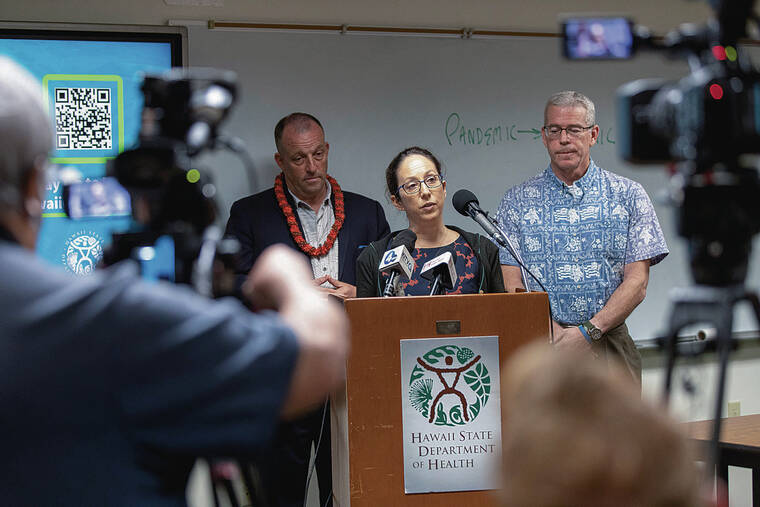
Mahalo for supporting Honolulu Star-Advertiser. Enjoy this free story!
With the end of Thursday came the expiration of the U.S. public health emergency for COVID-19.
Hawaii leaders marked the day, three years later, as a milestone while thanking health workers and residents for their efforts to keep the coronavirus at bay.
“Today is an important milestone,” said Dr. Kenneth Fink, state health director, at a news conference. “The end of the public health emergency represents a transition from COVID-19 being pandemic to being endemic. It means the worse is over but COVID-19 is still sticking around and something we’ll need to live with.”
Although the emergency is ending, Fink said it is still important to remain vigilant and continue to invest in public health preparedness.
Gov. Josh Green saluted health care workers who stood fast during the darkest moments, and those who made sacrifices during the pandemic.
He also thanked residents for wearing masks and getting vaccinated, noting these efforts paid off — and that Hawaii had the lowest mortality rate and one of the highest COVID-19 vaccination rates of any state.
“So what you did as a people in our culture to make sure we didn’t spread the virus to our loved ones or the workplace or at schools — that’s what saved lives,” he said. “So we thank you.”
The end of the federal public health emergency results in several changes to COVID-19- related initiatives.
According to the U.S. Department of Health and Human Services, which released a fact sheet earlier this week, access to COVID-19 vaccines and certain treatments such as Paxlovid will generally not be affected.
Dr. Sarah Kemble, state epidemiologist, said the government is still distributing free COVID-19 vaccines for adults and children and that DOH remains committed to ensuring equitable access to them.
Insurance generally will cover COVID-19 tests ordered by health care providers but could come with cost-sharing.
Insurance providers, however, are no longer required to cover costs for COVID-19 home tests.
Those with Medicaid will still be covered for COVID-19 testing and treatment at no cost through September 2024.
Vaccine requirements for federal workers and contractors, as well as foreign air travelers to the U.S., also ended Thursday.
The Centers for Disease Control and Prevention will discontinue reporting COVID-19 community levels and other metrics like test positivity as lab reporting requirements change and as case data become less reliable.
Kemble said DOH will maintain its COVID-19 dashboards and continue to share available data on case counts, test positivity rates, hospitalizations, deaths and vaccination coverage — and trends by county, age, race and ethnicity.
DOH will also continue to track coronavirus variants and wastewater trends.
But if certain metrics are no longer valid or helpful over time, she said, then DOH might make changes in the future.
Hawaii’s COVID-19 metrics and hospitalizations remained steady over the past week.
The weekly average of COVID-19 patients in hospitals remained in the same range, at 63 per day, with an average of five in intensive care, according to the Healthcare Association of Hawaii.
Four more deaths also were reported, bringing the state’s COVID-19 death toll to 1,896.
“While the federal public health emergency is ending, COVID-19 is not ending,” said Kemble. “Now is a great time to get up to date on COVID-19 shots. If you’re sick, stay home and wear a mask when around others to avoid spreading disease.”
And those who have not yet done so should get the recommended bivalent booster.
Green said the estimated number of COVID-19 deaths in Hawaii was at 4,479 per year and that with interventions the toll was far less.
“To imagine over three years more than 12,000 people could have passed if no action was taken is an extraordinary testament to what people in Hawaii are,” he said, “and the values we have when we care for our ohana.”
More than 1.1 million people died of COVID-19 in the U.S., which according to CDC was the third leading cause of death during 2020 and 2021, and the fourth leading cause of death in 2022.
WHAT’S COVERED, NOT COVERED NOW THAT THE COVID-19 EMERGENCY HAS ENDED
Covered
>> COVID-19 vaccine, for now, will still be available for free to adults and children through the federal government.
>> COVID-19 tests ordered by health care providers are generally expected to be covered by insurance but might come with cost-sharing.
>> Those with Medicaid coverage will have access to COVID-19 testing and treatment at no cost through September 2024.
Not covered
>> At-home COVID-19 tests. Insurance providers will no longer be required to waive costs or provide free at-home COVID-19 tests. For people with Medicaid, however, COVID-19 testing and treatment remain covered at no cost through September 2024.
For the uninsured
>> The uninsured may access free testing through CDC’s Increasing Community Access to Testing program. Find participating community and pharmacy partners via testinglocator.cdc.gov.
Still available
>> Through the end of May, eligible U.S. households can still order four free home tests via COVIDtests.gov.
For more information, visit hawiicovid19.com.
Source: HHS, DOH
Read More: World News | Entertainment News | Celeb News
Star Ads






